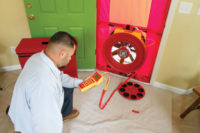Manufacturers of walk-in coolers and freezers; water heaters; deli-style coolers; through-the-wall central air conditioners and heat pumps; and small-duct, high-velocity systems are rejoicing the passage of HR 6582, the American Energy Manufacturing Technical Corrections Act.
Congressional Corrections
HR 6582 is a bipartisan bill that amends and rectifies current energy-efficiency laws for a range of HVACR product categories.
The measure, which was approved by the House of Representatives, 398-2, and gained unanimous approval in the Senate, was signed into law by President Obama on Dec. 19, 2012.
HR 6582 makes technical corrections to the Energy Independence and Security Act of 2007 that would reduce regulatory burdens and correct clerical errors, including updating the uniform efficiency descriptor for covered water heaters; clarifying language regarding regulatory treatment for small-duct, high-velocity systems; coordinating research and development of energy-efficient technologies for the industry; and establishing a separate, less stringent standard for over-the-counter commercial refrigerators.
“By codifying standards for these products, HR 6582 will create much needed stability and regulatory certainty for manufacturers and positively impact thousands of workers across the United States,” said Stephen Yurek, president and CEO, Air-Conditioning, Heating & Refrigeration Institute (AHRI). “We are grateful for the strong support and hard work on this bill by several of our member companies, as well as our legislative staff, and the many co-sponsors in the House and Senate. This is common sense legislation that will go a long way in helping our member companies as they work to rebuild our economy.”
Deli-Style Refrigerators
HR 6582 includes, almost in its entirety, HR 5719, the Better Use of Refrigeration Regulations (BURR) Act. The BURR Act, introduced by Rep. Lynn Westmoreland, R-Ga., lessens the regulatory burden on deli-style display cases by creating a separate product classification for service-over-the-counter (SOTC) refrigerator units. Previously, SOTC refrigerator units were required to meet efficiency standards designed for commercial, reach-in refrigerators. Due to a large surface area of display glass and additional lighting features, SOTC units struggle to meet the stringent requirements of traditional reach-in units established in the Energy Policy Act of 2005.
“This is just another example that the one-size-fits-all approach to regulations does not work,” said Westmoreland. “The BURR Act makes it so that the SOTC units have their own product class, with their own energy standards that American manufacturers can actually meet.”
Westmoreland believes the SOTC portion of HR 6582 will create about 8,500 jobs nationwide.
“With unemployment as high as it is, we need to focus on keeping production moving forward in America and protecting the jobs we have,” he said. “Now that these technical changes have been signed into law, we can finally give the employees of Lennox, and the other affected companies, some job security at no cost to the taxpayer.”
Small-Duct, High-Velocity
Small-duct, high-velocity systems achieve efficiency with the integration of an engineered duct system matched to blower and coil technology that is specific to that duct system. As air is distributed into the conditioned space, it creates a gentle suction which mixes the air, and the result is very even and consistent temperatures, superior comfort, and greater cost savings.
In 2000, Shawn Intagliata, president, Unico Inc., was pleased to discover that the U.S. Department of Energy (DOE) was considering establishing a new product classification for small-duct, high-velocity systems.
However, as the language was published in the DOE’s Federal Register, Intagliata, and other small-duct, high-velocity manufacturers, were surprised to discover that the DOE erroneously grouped small-duct, high-velocity systems with all air conditioners and heat pumps.
“The new small-duct, high-velocity product class was lumped in with traditional HVAC systems instead of being posted as its own product class. This oversight left small-duct, high-velocity manufacturers at a competitive disadvantage to systems that are actually less efficient.”
Intagliata said he alerted the DOE of the error, and they acknowledged the mistake, but subsequent action was delayed.
In 2001, as President Bill Clinton was leaving office, he issued an executive order raising efficiency standards on central air conditioning systems. After taking office, President George W. Bush rescinded several of Clinton’s standards, triggering the attention of various environmental organizations that argued “once an efficiency level is set, it can only be changed through congressional approval.”
A 2004 court ruling reversed Bush’s order, and established a law that granted Congress authority over all future efficiency alterations. The decision burdened Unico’s and other small-duct, high-velocity manufacturers’ ability to correct DOE’s clerical error.
“The clerical error resulted in the perception that the efficiency of a small-duct, high-velocity system is lower than the national requirement, which is not true,” said Intagliata. “We have a completely separate testing standard and an entirely different classification of product than traditional HVAC systems.
“As a system, we deliver at least 99 percent of the air that is being conditioned into the living space. This is called delivered-efficiency. Our ability to remove more relative humidity with our cooling coils, and our ability to have a greater heat rise across our heat coil adds to the efficiency. The proposed separate product class gave us credit for each of these features. Because of this 2004 ruling, we were on the outside looking in, and the only solution was to seek legislative relief.”
The DOE acknowledged the mistake and, according to Intagliata, “felt terrible.” To help alleviate the problem, the DOE proposed a temporary waiver for small-duct, high-velocity technology.
“Essentially, we were told you can continue to sell your American-made products in America, but only through a waiver, which will have to be renewed annually” he said. “While the waiver has been renewed each year, there was always a concern that this allowance could be taken away at any time.”
After six years of minimal legislative momentum, Unico, through a grassroots movement, began to attract congressional interest.
“We recognized that single-company bills aren’t a top priority in Congress, so we started inviting interested parties into a coalition,” said Intagliata. “We enlisted the help of Missouri Sens. Roy Blunt, Republican, and Claire McCaskill, Democrat, and Reps. John Shimkus, R-Ill., and Russ Carnahan, D-Mo., the American Council for an Energy-Efficient Economy (ACEEE), the AHRI, and others. We collected letters of support from constituents in Alabama, Georgia, Louisiana, Maryland, Massachusetts, Michigan, Missouri, and North Carolina — from all over the nation. We then took all this cumulative support to Washington, D.C., and started knocking on doors.
“Our coalition introduced bipartisan, standalone legislation in both the House and the Senate; we worked to include this legislation in a small package of technical corrections that was fully bipartisan and didn’t cost anything.”
HR 6582 was introduced by Rep. Robert B. Aderholt, R-Ala., on Nov. 2, 2012. Carnahan, was the lead sponsor for the Democrats. The bill included large portions of Sens. Jeanne Shaheen, D-N.H., and Rob Portman’s, R-Ohio, S. 1000, the Energy Savings and Industrial Competitiveness Act, and Westmoreland’s BURR Act. On Dec. 4, at approximately 2:11 p.m., the bill gained House approval, with only two of 400 voters dissenting.
“Since March 2010, I estimate we visited at least 250 legislative offices in Washington, D.C., and hosted many members of Congress at our manufacturing facilities in Missouri. This is a huge win for our company, workforce, and the local economy,” said Intagliata. “Approval of this measure is a great example of how working to cut excessive government regulations provides small businesses with the opportunity to grow and create more American manufacturing jobs. Small-duct, high-velocity technology saves energy for consumers. It’s refreshing to find that there are some very good people who want to do the right things on behalf of this country.”
Water Heaters
In addition to applying a consistent rating system for all water heaters, the American Energy Manufacturing Technical Corrections Act will require the DOE to develop a test method to accurately determine the descriptor for all types of water heaters, including new advanced technologies introduced over the last several years.
“Passage of this legislation will help reduce the confusion that consumers face when attempting to determine the energy efficiency of the water heater they intend to purchase,” said Paul W. Jones, chairman and CEO, A.O. Smith Corp., Milwaukee.
“Consumers will be able to make more informed decisions by comparing the efficiency of the entire range of water heaters that are on the market. It will make it easier for them to obtain available incentives that are based on an appliance’s energy efficiency.
“It’s also important to understand this legislation supports our national clean-energy goals by promoting the use of high-efficiency water heaters that reduce energy consumption and therefore reduce greenhouse-gas emissions,” said Jones.
The uniform energy-efficiency descriptor replaces a standard that is more than 20 years old that created two sets of energy-efficiency measures for water heaters. When the original standards were put in place, smaller water heaters were rated using an “energy factor,” while larger units were rated based on “thermal efficiency.”
Adding to the confusion, each of the two ratings required its own testing methodology, and manufacturers were not allowed to substitute ratings on different water-heater models. Advances in water heater technology and improved efficiency testing methods combined to make the older standard obsolete.
Publication date: 1/28/2013











